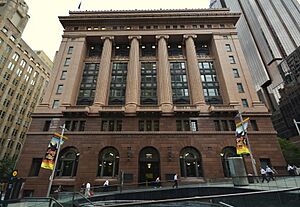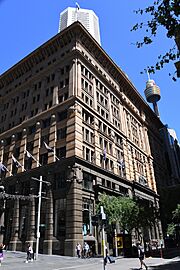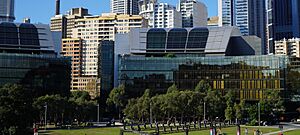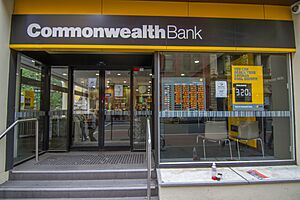Commonwealth Bank facts for kids
 |
|

1 Darling Park Headquarters, Sydney
|
|
| Public | |
| Traded as |
|
| ISIN | ISIN: [https://isin.toolforge.org/?language=en&isin=AU000000CBA7 AU000000CBA7] |
| Industry | Banking and financial services |
| Founded |
|
| Headquarters | Darling Park Tower 1, 201 Sussex Street,
,
Australia
|
|
Number of locations
|
|
|
Areas served
|
|
|
Key people
|
|
| Services |
CommBank services
Consumer banking
Corporate banking Credit cards Finance and insurance Global wealth management Investment banking Investment management Mortgages Private equity |
| Revenue | |
| Total assets | |
| Total equity | |
|
Number of employees
|
53,395 (2022) |
| Divisions |
CommBank divisions
Business and Private Banking
International Financial Services Institutional Banking and Markets Retail Banking Services Wealth Management |
| Subsidiaries |
CommBank subsidiaries
ASB Bank
Bankwest Colonial First State CommInsure Commonwealth Securities Sovereign Limited |
The Commonwealth Bank of Australia (CBA), or CommBank, is an Australian multinational bank with businesses across New Zealand, Asia, the United States, and the United Kingdom. It provides a variety of financial services, including retail, business and institutional banking, funds management, superannuation, insurance, investment, and broking services. The Commonwealth Bank is the largest Australian listed company on the Australian Securities Exchange as of August 2015, with brands including Bankwest, Colonial First State Investments, ASB Bank (New Zealand), Commonwealth Securities (CommSec) and Commonwealth Insurance (CommInsure). Its former constituent parts were the Commonwealth Trading Bank of Australia, the Commonwealth Savings Bank of Australia, and the Commonwealth Development Bank.
Founded in 1911 by the Australian Government and fully privatised in 1996, the Commonwealth Bank is one of the "big four" Australian banks, with the National Australia Bank (NAB), ANZ and Westpac. The bank was listed on the Australian Stock Exchange on 12 Sep 1991.
The former global headquarters of Commonwealth Bank were the Commonwealth Trading Bank Building on the corner of Pitt Street and Martin Place, Sydney, which was refurbished from 2012 for retail and commercial uses, and (from 1984 to 2012) the State Savings Bank Building on Martin Place, which was sold in 2012 to Macquarie Bank. The headquarters were moved to Tower 1, 201 Sussex Street and two new nine-storey buildings which were built at the site of the former Sega World Sydney, in Darling Harbour on the western side of Sydney's city centre.
In 2018, findings from the Royal Commission into Misconduct in the Banking, Superannuation and Financial Services Industry have indicated a negative culture within the bank, amid allegations of fraud, deception, and money laundering, among various other crimes.
In 2022, the Commonwealth Bank held the 49th position in the "Top 1000 World Banks".
Contents
History
Foundation (1911–1919)
The Commonwealth Bank of Australia was established by the Commonwealth Bank Act 1911, introduced by the Andrew Fisher Labor government, which favoured bank nationalisation, with effect on 22 December 1911. In a rare move for the time, the bank was to have both savings and general bank business. The bank was also the first bank in Australia to receive a federal government guarantee. The bank's earliest and most strenuous proponent was the flamboyant American-Australian Labor politician King O'Malley, and its first governor was Sir Denison Miller.
The bank opened its first branch in Melbourne on 15 July 1912. In an agreement with Australia Post that exists to this day, the bank also traded through post office agencies. In 1912, it took over the State Savings Bank of Tasmania, and by 1913 it had branches in all six states.
In 1916, the bank moved its head office to Sydney. It also followed the Australian army into New Guinea, where it opened a branch in Rabaul and agencies elsewhere.
Central bank (1920–1959)
In 1920, the bank began acquiring central bank powers when it took over the responsibility for the issue of Australian bank notes from the Department of the Treasury. Also in 1920, the Commonwealth Bank took over the Queensland Government Savings Bank.
In 1924, the federal government of Stanley Bruce sought to place further checks and limits on the powers of the governor of the bank, and passed the Commonwealth Bank Act, 1924, which created a seven-member Board of Directors comprising the governor, the Secretary of the Treasury, and six directors "actively engaged in agriculture, commerce, finance or industry", and a Chairman of the Board elected annual from its members. The first six board members were appointed on 10 October 1924: Sir John Garvan, Sir Robert Gibson, Sir Samuel Hordern, Robert McComas, Richard Samuel Drummond, and John McKenzie Lees. Garvan was appointed as the first chairman on 13 October 1924.
In 1931, the bank board came into conflict with the Labor government of James Scullin. The bank's chairman Sir Robert Gibson refused to expand credit in response to the Great Depression, as had been proposed by Treasurer Edward Theodore unless the government cut pensions, which Scullin refused to do. The conflict surrounding this issue led to the fall of the government, and to demands from Labor for reform of the bank and more direct government control over monetary policy.
Also in 1931, it took over the savings bank business of the Government Savings Bank of New South Wales (est. 1871), the current account and fixed deposit business of the NSW Rural Bank Department, and the State Savings Bank of Western Australia (est. 1863).
In 1942, the Commonwealth Banking Corporation (CBC) suspended its operations in Papua New Guinea as the Imperial Japanese Army captured many of the towns in which it operated, and bombed Port Moresby. The bank resumed operations later, possibly in 1944.
The bank had many branches across Papua New Guinea including Port Moresby, Boroko, Rabaul, Lae, Wau, Bulolo, Goroka, Kavieng, Madang, Mount Hagen, Kundiawa, Popondetta, and Wewak. On Bougainville, there was Kieta, Panguna, Arawa and early on a part-time sub-branch at Loloho. It maintained those facilities to support trade, local business, government, and small savers.
The Commonwealth Bank received almost all central bank powers in emergency legislation passed during World War II and at the end of the war, it used this power to begin a dramatic expansion of the economy. This was also the aim of the federal government at the time, which attempted to compel the Australian states to conduct their banking with the Commonwealth under the Banking Act 1945 (Cth), but the High Court in Melbourne Corporation v Commonwealth (1947) 74 CLR 31, blocked this move.
In August 1945, the federal government of Ben Chifley passed the Commonwealth Bank Act, 1945, which repealed the 1925 act and abolished the Board of Directors, returning full executive control of the bank to the governor.
The government also dramatically expanded immigration programs. In response, the bank established a Migrant Information Service (later known as the Australian Financial & Migrant Information Service, or AFMIS). The bank expanded during this period, and in just five years it opened hundreds of branches throughout Australia and in 1951 it established a branch in the Solomon Islands.
In 1958 and 1959, there was a controversy concerning the dual functions of the organization, operating as the central bank on the one hand and a commercial bank on the other. As a result, the government separated the two roles, creating the Reserve Bank of Australia to exercise the central bank function, and leaving the Commonwealth Banking Corporation to operate purely as a commercial bank. Those commercial functions were exercised by the organization's constituent sections: the Commonwealth Trading Bank of Australia, the Commonwealth Savings Bank of Australia, and the newly-formed Commonwealth Development Bank.
From 1958 to 1976 the Commonwealth Bank operated savings bank agencies in the New Hebrides.
Diversification (1960–1991)
A new Commonwealth Development Bank was established in 1960 and during the 1970s the bank diversified its business into areas like insurance and travel. It established a finance company, CBFC in 1974. The bank also became more heavily involved in foreign currency trading and international banking in general.
The bank actively supported the introduction of decimal currency in the years leading up to 1966 and, like most banks, it gradually converted its paper records onto a new computer-based system. The bank created the first credit card in Australia in 1974 when it established Bankcard. In later years the bank began offering MasterCard (1984) and Visa (1993) cards as well.
In 1974, as Papua New Guinea approached independence, the bank formally handed over its PNG operations to the newly created and government-owned Papua New Guinea Banking Corporation (PNGBC). The bank retained a restricted branch in Port Moresby that it finally closed in 1982.
In 1981 the bank transferred its operations in the Solomon Islands to the National Bank of Solomon Islands, which operated as a joint venture (51% Commonwealth Bank, 49% Government of the Solomon Islands).
In 1989 the bank acquired 75 per cent of ASB Bank in New Zealand.
In 1991 the bank acquired the failing Victorian Government-owned State Bank of Victoria (est. 1842).
Privatisation (1991–present)

Between 1991 and 1996 the Australian Government under the Keating government fully privatised the Commonwealth Bank. The first share offer in 1991 was valued at $1,292 million, the second in 1993 for $1,700 million and the third was sold for $5,000 million in 1996. It is a public company, but one of the few such companies in Australia whose official name does not end in 'Limited'.
In 1994 Commonwealth sold its shares in National Bank of Solomon Islands to Bank of Hawaii. In 1994, Commonwealth took a 50% share in PT Bank International Indonesia.
On 10 March 2000, the Commonwealth Bank and Colonial Limited announced their intention to merge, with seven Commonwealth Bank shares being offered for twenty Colonial Shares. The merger received final approval from the Supreme Court of Victoria on 31 May 2000 and was completed on 13 June 2000. This brought into the fold Colonial’s stake in Colonial National Bank, the former National Bank of Fiji. The bank also acquired the remaining 25% of ASB Bank.
Banking opportunities in Asia saw the Bank in 2000 acquire full ownership of PT Bank International Indonesia and rename it (PT Bank Commonwealth). This bank now has over 16 branches and has opened several FX shops to cater to Commonwealth Bank clients who are tourists in Bali.
In 2005, the bank established strategic co-operation agreements with two Chinese banks, Jinan City Commercial Bank and Hangzhou City Commercial Bank; it took an 11% stake in Jinan Commercial, and a 19.9% stake in Hangzhou Commercial. Commonwealth also established a representative office in Bangalore, India.
On 27 January 2006, the bank acquired the remaining 49% stake in Colonial National Bank (Fiji).
At the beginning of 2008, Commonwealth Bank opened a branch in Ho Chi Minh City (Saigon). Then in October, Commonwealth announced that it had purchased Bankwest and St Andrew's Insurances from their parent company HBOS for A$2.1 billion. The acquisition was scheduled to be completed in early 2009, subject to regulatory approval. Lastly, on 24 December, Commonwealth announced that it had, in joint partnership with Aussie Home Loans, purchased Wizard Home Loans. As part of the deal, the Commonwealth Bank will acquire Wizard mortgages up to the value of A$4 billion. Commonwealth Bank held about 30 percent of the loan business of financial advisory company Storm Financial when it collapsed in January 2009.
In December 2009, Commonwealth sold Colonial National Bank to Bank of South Pacific.
The bank transferred its ATM service desk from HP Enterprise Services in Adelaide to ITS (Armaguard) in Sydney in March 2012. The bank will change from NCR and Diebold ATMs to Wincor Nixdorf ATMs over the coming years.
The bank is the only financial services organisation to appear in the Dream Employers' top 20 list of preferred employers for 2010 and 2011.
During the Royal Commission into Misconduct in the Banking, Superannuation and Financial Services Industry it was discovered that the Commonwealth Bank had charged dead people for financial advice services. On 9 May 2018, Commonwealth Bank settled an interest rate rigging case brought by ASIC for $25 million. In the settlement, the bank admitted it engaged in "unconscionable conduct" and manipulated the bank bill swap rate five times between February and June 2012.
On 16 November 2023, the bank announced divestment of PT Bank Commonwealth to Bank OCBC NISP.
Bank structure
Customer Service Network
This division delivers financial services to personal and small business customers. It provides bank accounts and credit products to consumers.
Premium Business Services
Premium Business Services was formally split into two departments in 2009, Institutional Banking & Markets (IB&M) and Business & Private Banking (B&PB). IB&M includes areas of the bank that provides services to Institutional Clients and Global Markets. B&PB includes areas of the bank that provides services to Business customers and private banking customers.
Wealth Management
Wealth Management brings together the Groups funds management platform, master funds, superannuation, insurance and financial advice business support. Colonial First State, Colonial First State Global Asset Management and CommInsure all form part of Wealth Management. CBA has been granted a MySuper authority, enabling it to continue to receive default superannuation contribution from 1 January 2014.
Executive leadership
Governors/Chief Executive Officers
The following individuals have been appointed to serve as chief executive of the Commonwealth Bank of Australia, or precursor titles:
| Order | Name | Title | Term start | Term end | Time in office |
|---|---|---|---|---|---|
| 1 | Sir Denison Miller KCMG | Governor | June 1912 | June 1923 | 11 years, 29 days |
| 2 | James Kell | June 1923 | October 1926 | 3 years, 122 days | |
| 3 | Sir Ernest Riddle | October 1926 | February 1938 | 11 years, 121 days | |
| 4 | Sir Harry Sheehan CBE | March 1938 | March 1941 | 3 years, 0 days | |
| 5 | Hugh Traill Armitage CMG | July 1941 | December 1948 | 7 years, 183 days | |
| 6 | Dr H. C. Coombs | January 1949 | January 1960 | 11 years, 0 days | |
| 7 | Ernest Richardson CBE | Managing Director | January 1960 | March 1965 | 5 years, 89 days |
| 8 | Sir Bede Callaghan CBE | May 1965 | August 1976 | 11 years, 92 days | |
| 9 | Sir Ronald Elliott | August 1976 | August 1981 | 5 years, 0 days | |
| 10 | Vern Christie AO | August 1981 | March 1987 | 5 years, 212 days | |
| 11 | Donald Sanders AO CB | March 1987 | December 1990 | 3 years, 275 days | |
| Chief Executive Officer | January 1991 | June 1992 | 1 year, 181 days | ||
| 12 | David Murray AO | June 1992 | September 2005 | 13 years, 92 days | |
| 13 | Sir Ralph Norris KNZM | September 2005 | November 2011 | 6 years, 29 days | |
| 14 | Ian Narev | December 2011 | April 2018 | 6 years, 128 days | |
| 15 | Matt Comyn | April 2018 | incumbent | 7 years, 20 days |
Chairs of the Board
| Order | Name | Term start | Term end | Time in office | Notes |
|---|---|---|---|---|---|
| 1 | Sir John Garvan | 13 October 1924 | 30 August 1926 | 1 year, 321 days | |
| 2 | Sir Robert Gibson GBE | 13 September 1926 | 1 January 1934 | 7 years, 110 days | |
| 3 | Sir Claude Reading KCMG | 4 January 1934 | 21 August 1945 | 11 years, 229 days | |
| Board abolished, 1945–1960 | |||||
| 4 | Sir Warren McDonald KBE | 1 January 1960 | 12 November 1965 | 5 years, 315 days | |
| – | Geoffrey Rushworth (acting) | 12 November 1965 | 27 October 1966 | 349 days | |
| 5 | Sir Roland Wilson | 28 October 1966 | 13 February 1975 | 8 years, 108 days | |
| 6 | Finlay Crisp | 14 February 1975 | 21 December 1984 | 9 years, 311 days | |
| 7 | Sir Brian Massy-Greene | 21 December 1984 | 7 March 1988 | 3 years, 77 days | |
| 8 | Tim Besley AC | 8 March 1988 | 31 October 1999 | 11 years, 237 days | |
| 9 | John Ralph AO | 1 November 1999 | 5 November 2004 | 5 years, 4 days | |
| 10 | John Schubert AO | 5 November 2004 | 1 February 2010 | 5 years, 88 days | |
| 11 | David Turner | 1 February 2010 | 31 December 2016 | 6 years, 334 days | |
| 12 | Catherine Livingstone AO | 1 January 2017 | 9 August 2022 | 5 years, 220 days | |
| 13 | Paul O’Malley | 10 August 2022 | Incumbent | 2 years, 262 days | |
International operations
The Commonwealth Bank's international presence includes:
- Retail banks in New Zealand (ASB Bank),Turkey (CommBiz) and Indonesia (99% of PT Bank Commonwealth)
- Banking investments in China (20 per cent in both Qilu Bank and Bank of Hangzhou) and Vietnam, (20 per cent stake in Vietnam International Bank)
- County banks in Hebei and Henen Provinces of China (15 branches and 8 sub-branches)
- Commonwealth Bank branches in London, New York City, Tokyo, Hong Kong, Shanghai, Beijing, Singapore, Auckland, Turkey and Mumbai
- Joint venture life insurance businesses in Indonesia (PT Commonwealth Life) and China (37.5% stake in BoCommLife)
- First State funds management business in the United Kingdom, Germany, France, Hong Kong, Singapore, Indonesia, Japan, United States and Dubai
- Representative office in Hanoi
- A Global Capability Center in Bangalore, India
Products and services
The Commonwealth Bank is Australia's largest retail bank and offers customers a range of products and services, including loans, credit cards, transaction and savings accounts. It has the largest branch and ATM network. It also offers services to people planning to move to Australia.
NetBank
The Commonwealth Bank offers online banking services through NetBank. NetBank allows customers to transfer funds, manage accounts, access assets and liabilities and also manage savings and saving goals. NetBank is also offered with a mobile app available for iOS and Android.
Beem It
Beem It is an instant payment free-to-download mobile application owned by Commonwealth Bank, NAB and Westpac later sold to Eftpos Australia. It offers an instant payment transfer service between registered users of the app regardless of which bank they are with. The app's main features include options to pay, transfer, request and split money.
Subsidiaries
Australia
- Bankwest
- Colonial First State
- CommInsure
- Commonwealth Securities
Asia Pacific
- PT Bank Commonwealth (Indonesia)
New Zealand
- ASB
Turkey
- TR Commbiz (Turkey)
Sponsorship
Commonwealth Bank has been sponsoring Cricket Australia for the women's game since the 1990s.
In April 2021, Commonwealth Bank secured a four-year partnership deal with Football Australia for the naming rights of the women's national football teams as the Commonwealth Bank Matildas, Commonwealth Bank Young Matildas, and Commonwealth Bank Junior Matildas.
In November 2022, FIFA announced that Commonwealth Bank has signed on as an official supporter for the 2023 FIFA Women's World Cup.
Profits By Year
| Year | Profit | |
|---|---|---|
| 2010 | ||
| 2011 | ||
| 2012 | ||
| 2013 | ||
| 2014 | ||
| 2015 | ||
| 2016 | ||
| 2017 | ||
| 2018 | ||
| 2019 | ||
| 2020 | ||
| 2021 | ||
| 2022 | ||
| 2023 |
See also
 In Spanish: Commonwealth Bank para niños
In Spanish: Commonwealth Bank para niños
- Australian Cricket Academy
- Banking in Australia
- Commonwealth Bank Series
- Commonwealth Bank Trophy
- List of banks in Australia
- List of banks in Oceania
- Reserve Bank of Australia
- State Bank of New South Wales
- State Bank of Victoria






